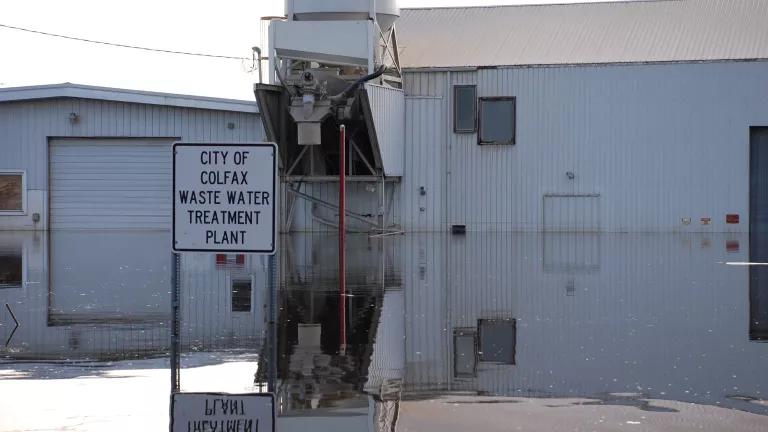
The White House took a major step to address the growing risks of flooding. On January 30, the White House issued an executive order that significantly improves the flood risk standards that federal agencies will use when designing, building, or funding public infrastructure and other projects. The new standard will not only bolster our protections against flooding in the near term, but also will encourage agencies to assess future flood risk, particularly how flood risk may increase in response to climate change.
Water and wastewater treatment plants are examples of public infrastructure that is vulnerable to flooding. New standards will help improve siting and protection of these critical - but vulnerable - assets.FEMA photo by Leo 'Jace' Anderson - Aug 15, 2010
The new standard is a big improvement and establishes a new level of protection, defined by one of three benchmarks that agencies can select:
- The elevation of the 100-year flood (a 100-year flood has a 1 percent chance of occurring in any given year) plus a projection of how much higher flood elevations may rise in response to climate change;
- The 100-year flood level plus 2 feet of elevation for standard projects and 3 feet of elevation for critical projects; or
- The 500-year flood level (a flood with a 0.2 percent chance of occurring in any given year).
The new standard is a long overdue recognition that flood risks are not static and change in response to a variety of factors including development patterns; alterations to river channels, floodplains, and coastlines; changes in precipitation patterns; and climate change. Previously, federal agencies were generally only required to consider the 100-year flood level, and if this option was not feasible, abide by the minimum requirements of the NFIP.
In 2013 FEMA released an analysis of the impacts of climate change on the nation's flood risks, which found that coastal areas would become increasingly vulnerable due to sea level rise, and communities on rivers (particularly in the Midwest and Pacific Northwest) would be more susceptible to floods due to changing precipitation patterns. The executive order signed by President Obama recognizes that we cannot rely on past experience or out of date flood maps alone to predict the future for events like flooding and other natural disasters, which are influenced by the climate.
Some states have already moved ahead with similarly stringent flood protection standards. New Jersey recently adopted the 500-year floodplain elevation as the standard that new wastewater treatment plants and drinking water treatment plants need to build to in order to be eligible for state financial support. New York also applied a standard similar as the new executive order for water infrastructure repairs funded by the state in the wake of Superstorm Sandy.
One need only look at the numbers on where states have sited public facilities and critical infrastructure to understand the necessity of the President's actions. NRDC did a quick review of state hazard mitigation plans and found the following information:
Virginia -- $1.7 billion worth of state facilities are sited in the 100-year floodplain
Florida -- $25 billion worth of state facilities are built within the 500-year floodplain
Illinois -- 405 critical state and local facilities located in floodplains including waste-water treatment plants (146), potable-water treatment (33),schools (95), fire stations (48), and police stations (26) and communication facilities (25). It is important to begin planning ahead to determine how these might be protected or relocated
California -- $11.6 billion worth of state facilities are built in the 100-year floodplain
The fact of the matter is that we have too often put public facilities in vulnerable floodplains (using taxpayer dollars to do so). When these facilities are flooded, taxpayers again foot the bill for repeated repairs. The President's executive order will help steer federal infrastructure investments away from areas that will be increasingly vulnerable to future flooding, saving money over the long run and decreasing the nation's overall vulnerability to flooding.

